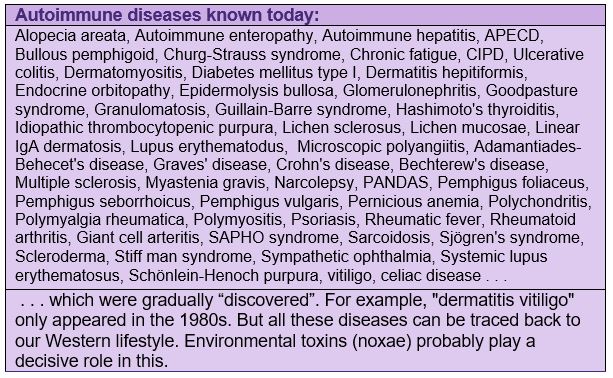Health
Autoimmune Disease?
Solution: Prevention!
Autoimmunity is one of the most common diseases today – depending on the affected tissue, a wide variety of signs of disease can appear. But the cell biology and biochemistry hidden behind it are always the same. Our author – cancer researcher Isolde Riede – goes in search of clues and also comes across the reason for elevated cholesterol levels.
By Dr. Isolde Riede (Hp.), Überlingen
When the immune system attacks the body’s own tissue, it is called autoimmunity. The signs of the disease can be varied, depending on which tissue in the body is affected by the attack of the immune system. Autoimmunity is one of the most common diseases today. It was only in the 1960s that it could first be proven.
In 1951, it was noticed that cortisone could improve skin sensitivity. And it was already known that cortisone reduces the activity of the immune system. Only in the 1960s were the first clinical pictures described in the journal “The Lancet” behind which autoimmunity was suspected. In 1963, autoantibodies were found for the first time. Two years later, a biochemical connection with allergies was established. Since then, more and more clinical pictures have been added.

Thousands of studies
More and more scientific studies on autoimmunity are being published. PubMed is a data collection of the National Institutes of Health, USA. There are a total of 33 publications on autoimmunity from 1971. In 2001, almost 1,000 publications were registered, and in 2021, more than 19,000 publications describe aspects of autoimmunity. However, what is missing? – how autoimmunity can be prevented or cured. Depending on the affected tissue, individual signs of the disease can be seen. Each disease is given its own name, although the cell biology and biochemistry behind it are the same. Thus, you must not look specifically at individual diseases, but rather show examples that can be generalized.
Health Insurance Alert
The health insurance companies are sounding the alarm that public health is at risk. One example mentioned is the development of atopic indications in children. With that [indication] many children develop neurodermatitis or asthma after birth. In 1960, these were exceptional cases, almost all children came into the world without these indications. As early as 1990, 30 percent of all newborns were affected. According to more recent figures, twice as many cases occurred in 2010, so meanwhile 60 percent of children are no longer healthy. It is predicted that by 2040 no more healthy children will be born here in the West – if nothing happens.
Type II diabetes is now also a widespread disease. Especially older people develop autoantibodies against the Islets of Langerhans in the pancreas. These are subsequently reduced. However, since insulin is produced there, this is accompanied by an insulin deficiency. As a result, glucose in the blood rises and provokes the well-known long-term effects. Here also this is not a static problem for a few people. As early as 2009, the A.O.K. [one of the German private healthcare insurance companies] reported that the number of diabetics had risen by almost 50 percent within nine years. Half of all people over the age of 65 have diabetes, and the trend is rising.
Is this also an indication that we are eating the wrong food, eating too much sugar? Conversely, too much of something always means: too little of something else. About 150 out of 100,000 people become ill with multiple sclerosis (MS) – another disease of autoimmunity. Here the immune system breaks down the myelin sheaths of the nerves, and in the image “holes” appear in the brain like in a Swiss cheese. Not only the brain is affected, many other organs are affected. Environmental factors play a role, and women are affected more often than men. Pathogens can also play a role. For example, an outbreak of MS on a closed island correlated with the emergence of canine distemper. Canine distemper is a symptomatically similar disease in animals.
Many viruses carry sections (epitopes) that are identical to the epitopes of the body’s own tissue. Thus, for example, the infection of such a virus and the attack of the immune system against the virus could lead to “false” antibodies. Such false antibodies could then lead to autoimmunity.
Each disease has its own name – but the triggers are always the same.
A blatant Vitamin D deficiency was also discovered in MS patients. Obviously, many people receive far too little sunlight, thus they spend too much time indoors. Sunlight not only leads to the body’s own production of Vitamin D, but also induces other effects that have a positive influence on the immune system.
The following causes for the development of autoimmunity have been defined so far:
- Environmental noxious agents
- Dietary errors
- Viruses
First of all, it should be noted that the immune system must be able to distinguish its own tissue from foreign tissue. The information carriers are the histocompatibility antigens (HLA). These are located on the surface of all the body’s own cells. The immune system learns them in the embryonic phase. Everything that later enters the body and does not carry this HLA is recognized as foreign, attacked and reduced.

Environmental Noxious Agents
Combustion engines get hot, which causes them to excrete pollutants: Among other things, nitrogen compounds (NOX) are formed. These react with oxygen to form NO and NO2. When NO2 comes into contact with water, it dissolves in it and HNO3, nitric acid, is formed. Sulphur compounds are also formed from the sulphur components of the fuel (SOX) during combustion processes. When these gases come into contact with water, sulfurous acid and sulfuric acid are formed.
Acids In the Lungs
We have known the consequences of these acids since the 1980s, when we noticed that acid rain was damaging our forests. And of course, these gases do not just harm the forest. When you inhale them and the acids are created in the lungs, they etch damage into the tissue there.
CFCs and Ozone
The development of a new economy after the Second World War gave rise to many new products: spray cans for deodorants, for hair, etc. The propellant CFCs used in them rises into the upper layers of the air and destroys the ozone there. Ozone is formed there when sunlight meets oxygen, and converts 3 x O2 (oxygen) into 2 x O3 (ozone). This ozone absorbs UV radiation, which then no longer reaches the earth.
When CFCs break down this ozone in the [upper layers], the UV radiation reaches the earth’s surface, and there the radiation produces ground-level ozone. Ozone is relatively unstable, and breaks down again into an oxygen molecule and an oxygen radical. This free radical is very aggressive and oxidizes everything it encounters. When we breathe in ozone, the oxygen radical oxidizes cells in the lungs. Ozone can also be transported in the blood, then decay somewhere in the body and oxidize something there.
 The cell membrane: Ozone oxidizes the unsaturated fatty acids (bent yellow lines) into saturated fatty acids (straight yellow lines) and thus reduces fluidity. In this way, the body also becomes “leaky”, substances penetrate that have no place there.
The cell membrane: Ozone oxidizes the unsaturated fatty acids (bent yellow lines) into saturated fatty acids (straight yellow lines) and thus reduces fluidity. In this way, the body also becomes “leaky”, substances penetrate that have no place there.
Effect On Cells
Our cell membranes are the barrier between the outside and the inside. If they are damaged, a great many bodily functions can no longer function well. They are physically in a “fluid” state. On the one hand, they should be stable. This is achieved by a hydrophobic, i.e. water-repellent interior. There are many fatty acids there (see in the figure above: yellow lines). A hydrophilic, thus water-loving exterior (blue stars) seals the membrane. On the other hand, the membrane must be “movable”. The proteins located there (oval structure) must be able to “swim”. This is achieved by many unsaturated fatty acids (yellow, bent lines).
Cholesterol (C) can increase fluidity in the membrane. Life is possible (red arrows) in a narrow range of fluidity. If it is too hot, we burn because the structure falls apart and is no longer stable. If it is too cold, we freeze to death because the membrane becomes quasi-crystalline.
One can imagine that the structure freezes bit-by-bit like ice floes. With such an “ice-bound” membrane, there are fewer and fewer essential fatty acids present, which makes it leaky. This is because the protein inside it is in a different state and has changed its surface. This membrane then shows itself to be foreign to the immune system: autoimmunity has developed.

Reaction: Cholesterol
Since the 1980s, the cholesterol level of the population as a whole has been rising steadily. In the past – as late as the 1980s – a cholesterol level below 100 mg/dl was normal. Today you can be happy to be below 250 mg/dl. Why? Because the body starts a repair mechanism for its membranes with the production of cholesterol. Thus if the membranes are threatened – for example, if fluidity decreases due to ozone – then more cholesterol is produced in the liver in order to repair the membranes. The result: the cholesterol level rises.
Cholesterol production is a repair mechanism for cell membranes.
Fat And No Sugar
Consequently, allergy and autoimmunity belong to the same biochemical origin: Leaky or cell membranes changed in structure cause the problems. In order to repair the cell membranes, it makes sense to consume high-quality vegetable oils. By increasing the intake of essential fatty acids (= unsaturated fatty acids), you can also lower the cholesterol level again.
Unfortunately, fewer and fewer people are using oil for their salad. They prefer to use a ready-made dressing and fat also has a bad reputation in cooking. However, we need to consume essential fatty acids because we cannot produce them ourselves. We should see it as a building material. In return, white industrial sugar should be avoided completely.
Avoid Noxious Agents
We can also avoid inhaling too many harmful substances by avoiding long and fast car journeys or switching to public transport. In the train you definitely breathe in less air pollutants than on the motorway. Ozone pollution can also be reduced. The air-ozone concentration is highest on sunny days in the afternoon between 2 and 4 p.m. If you then stay in closed rooms, you can avoid a lot of harmful ozone. So you should fill up on sunlight in the morning, or after 4 p.m. Another source of ozone in our everyday lives are laser printers. In these, electrostatic processes can occur, as a result of which ozone can be formed. If there is a lot of printing in offices, you should often ventilate well.
Result
Autoimmunity is a disease of civilization. We have created them through our way of life: we allow exhaust fumes, have allowed CFCs to escape for a long time against our better judgement, eat too much sugar and too few essential fatty acids. Our cell membranes are attacked, fluidity has dropped, the cholesterol repair mechanism is tense and reaches its limits. Proteins fall into a different form, which the immune system then recognizes as “foreign” and therefore attacks. We can – indeed we must – take countermeasures.

An Exclusive Translated Article for P2P Supporters
From the Monthly Publications of P2P
Published March 2025
From an article in raum&zeit, Volume 43, Issue 253, Jan/Feb 2025
Translation & redaction by: Carolyn L. Winsor, P2P Consulting
© Copyright 2025, raum&zeit, Dr. Isolde Riede, HP, Überlingern, Germany
Digital and online translation assistance utilized.

Book Tip:
Isolde Riede “My Path to New Therapies: Gentle Methods for the Treatment of Tumor Diseases, Lyme Disease and Autoimmunity”, Independent Cancer Research, 2023, €14.79, ISBN 978-3000774843



